Bosch 800, SHXM78W52N, SHX878WD5N, SHP878WD6N, SHX878WD2N Instruction Manual
...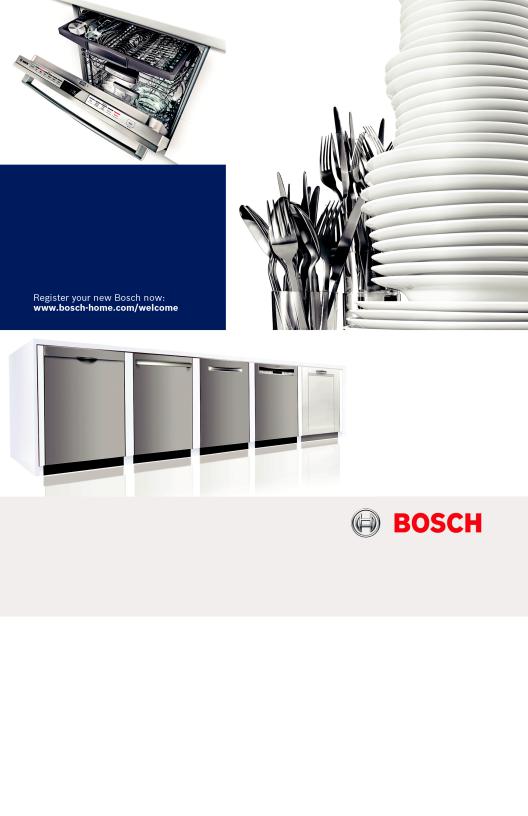
Dishwasher
SHXM63WS5N, SHP*78W***, SHX*78W***, SHV*78W***, SHPM98W***, SHXM98W***, SHVM98W***
en-us Operating instructions fr-ca Notice d'utilisation
2
en-us
Table of contents
(Safety Definitions. . . . . . . . . . .5
(IMPORTANT SAFETY INSTRUCTIONS . . . . . . . . . . . .6
ƒCauses of Damage. . . . . . . . . .9
*Getting Started . . . . . . . . . . . .10
+Water softening system / special salt * . . . . . . . . . . . . . .13
,Rinse Aid. . . . . . . . . . . . . . . . .15
-Loading the Dishwasher . . . .17
.Detergent . . . . . . . . . . . . . . . .29
/Dishwasher Cycles . . . . . . . .31
0Dishwasher Cycle Options . .32
1Operating the Dishwasher. . .35
2Care and Maintenance . . . . . .40
3Troubleshooting. . . . . . . . . . .45
4Customer Service. . . . . . . . . .52
‡Statement of Limited Product Warranty . . . . . . . . . . . . . . . . .53
3
en-us
'HDU 9DOXHG &XVWRPHU
7KDQN \RX IRU VHOHFWLQJ D %RVFK GLVKZDVKHU <RX KDYH MRLQHG WKH PDQ\ FRQVXPHUV ZKR GHPDQG TXLHW DQG VXSHULRU SHUIRUPDQFH IURP WKHLU GLVKZDVKHUV
7KLV PDQXDO ZDV ZULWWHQ ZLWK \RXU VDIHW\ DQG FRQYHQLHQFH LQ PLQG DQG WKH LQIRUPDWLRQ FRQWDLQHG KHUHLQ LV YHU\ LPSRUWDQW :H KLJKO\ UHFRPPHQG WKDW \RX UHDG WKLV PDQXDO EHIRUH XVLQJ \RXU GLVKZDVKHU IRU WKH ILUVW WLPH
7R OHDUQ PRUH DERXW \RXU GLVKZDVKHU DQG DYDLODEOH DFFHVVRULHV DV ZHOO DV PDQ\ RWKHU WRS TXDOLW\ %RVFK DSSOLDQFHV YLVLW RXU ZHE VLWH DW
ZZZ ERVFK KRPH FRP XV 86$
RU
ZZZ ERVFK KRPH FD &DQDGD
:KLOH WKHUH GRQ·W IRUJHW WR UHJLVWHU \RXU QHZ GLVKZDVKHU E\ FOLFNLQJ RQ WKH ´6XSSRUWµ WDE RU ILOOLQJ RXW WKH SURGXFW UHJLVWUDWLRQ FDUG HQFORVHG ZLWK \RXU QHZ XQLW
,I \RX KDYH DQ\ TXHVWLRQV RU FRPPHQWV SOHDVH FRQWDFW XV E\ SKRQH DW
RU ZULWH XV DW
%6+ +RPH $SSOLDQFHV &RUSRUDWLRQ0DLQ 6WUHHW 6XLWH ,UYLQH &$
4

Safety Definitions en-us
(Safety Definitions
9 WARNING
This indicates that death or serious injuries may occur as a result of non-observance of this warning.
9 CAUTION
This indicates that minor or moderate injuries may occur as a result of non-observance of this warning.
NOTICE
This indicates that damage to the appliance or property may occur as a result of non-compliance with this advisory.
Note: This alerts you to important information and/or tips.
5

9 IMPORTANT SAFETY INSTRUCTIONS
READ AND SAVE THESE INSTRUCTIONS
This dishwasher is provided with Installation Instructions and this Use and Care Manual. Read and understand all instructions before using the dishwasher.
This dishwasher is intended for use up to a maximum altitude of 13,000 ft (4,000 meters) above sea level.
To reduce the risk of fire, electrical shock, or serious injury, observe the following:
9 WARNING
RISK OF INJURY OR DEATH! Misuse of the dishwasher can result in serious injury or death. Do not use the dishwasher in any way not covered in this manual or for any purpose other than those explained in the following pages.
9 WARNING
RISK OF INJURY!
Severe injury and/or product damage could result from the use of unauthorized service technicians or non-original replacement parts. All repairs must be performed by an authorized service technician using only original equipment factory replacement parts.
9 WARNING
RISK OF ELECTRICAL SHOCK OR FIRE!
Electrical shock or fire could result if the electrical supply for the dishwasher covered in this manual is incorrectly installed or if the dishwasher has been improperly grounded. Do not use the dishwasher covered in this manual unless you are certain the electrical supply has been correctly installed and the dishwasher has been properly grounded.
9 WARNING
HEALTH HAZARD!
Never use harsh chemicals to clean your dishwasher. Some bleach-based products can damage your dishwasher and may present health hazards!
GROUNDING INSTRUCTIONS
This appliance must be grounded to a metal, permanent wiring system or an equipment grounding conductor must be run with the circuit conductors and connected to the equipment grounding terminal or lead on the dishwasher. See the Installation Instructions included with this dishwasher for more information on electrical requirements.
6

9 IMPORTANT SAFETY INSTRUCTIONS
READ AND SAVE THESE INSTRUCTIONS
9 WARNING
RISK OF ELECTRIC SHOCK! This appliance must be grounded. In the event of a malfunction or breakdown, grounding will reduce the risk of electric shock by providing a path of least resistance for electric current. This appliance is equipped with a cord having an equipment-grounding conductor.
Improper connection of the equipment-grounding conductor can result in risk of electric shock. Check with a qualified electrician if you are in doubt whether the appliance is properly grounded.
Safe Operation
Use this dishwasher only for its intended function, which is the washing of household dishware and kitchenware rated as dishwasher safe.
Use only detergents or rinsing agents recommended for use in a dishwasher, and keep them out of the reach of children.
9 CAUTION
When loading items to be washed:
■Locate sharp items so they are not likely to damage the door seal.
■Load knives and other sharp utensils with their HANDLES UP to reduce the risk of cut-type injuries.
■Do not wash plastic items unless they are marked “dishwasher safe” or the equivalent. For plastic items not so marked, check the manufacturer’s recommendations.
■Do not operate your dishwasher unless all enclosure panels are in place.
■Do not tamper with or override controls and interlocks.
Do not abuse, sit or stand on the door or dish racks of the dishwasher.
9 WARNING
RISK OF INJURY!
To avoid risk of injury, always use caution when opening the door during or following a wash cycle as hot water or steam may escape. Do not fully open the door until water noises have stopped and steam has subsided.
NSF/ANSI 184 Certified residential dishwashers are not intended for licensed food establishments.
Child Safety
To reduce risk of injury, do not allow children to play in or on the dishwasher.
When children become old enough to operate the appliance, it is the responsibility of the parents/legal guardians to ensure the children are instructed in safe practices by qualified persons.
7

9 IMPORTANT SAFETY INSTRUCTIONS
READ AND SAVE THESE INSTRUCTIONS
Proper Care and Maintenance
9 WARNING
RISK OF EXPLOSION! Under certain conditions,
hydrogen gas may be produced in a hot water system that has not been used for two weeks or more. Hydrogen gas is explosive. Before using a dishwasher that is connected to a hot water system that has been unused for two weeks or longer, turn on all hot water faucets and let the water flow from each for several minutes. This will release any accumulated hydrogen gas. As the gas is explosive, do not smoke or use an open flame during this time.
Remove the dishwasher door to the washing compartment when removing an old dishwasher for service or discarding.
To avoid floor damage and possible mold growth, do not allow wet areas to remain around or under the dishwasher.
To avoid dishwasher damage, do not allow water to remain in your dishwasher systems through extended periods of freezing temperatures. Freezing temperatures can damage the water fill valve and potentially other components of your dishwasher.
NOTICE
It is highly recommended for the end user to become familiar with the procedure to shut off the incoming water supply and the procedure to shut off the incoming power supply. See the Installation Instructions or contact your installer for more information.
State of California Proposition 65
Warning:
9 WARNING
This product can expose you to chemicals including vinyl chloride, which is known to the State of California to cause cancer and birth defects or other reproductive harm. For more information go to
www.P65Warnings.ca.gov.
8

Causes of Damage en-us
ƒCauses of Damage
NOTICES
■Never use steam cleaning products to clean your dishwasher. The manufacturer will not be liable for the possible damages or consequences.
■Bleach-based wipes can cause stainless-steel doors and tubs to rust.
■Using harsh chemicals
(e.g. bleach), abrasive cleaners, scouring pads (metal or plastic), or abrasive cloths/paper towels can damage your dishwasher’s exterior door panel, fascia panel and buttons.
■To avoid dishwasher damage, do not load the dishwasher with paper products, plastic bags, packing materials or anything other than normal, dishwasher safe dishware and kitchenware.
9
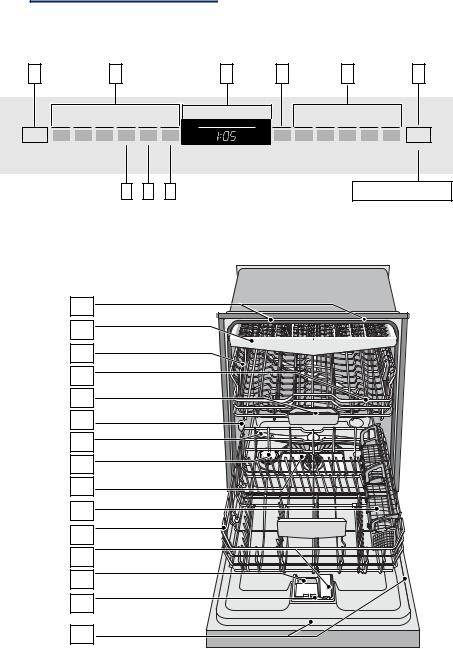
en-us Getting Started
*Getting Started
Appliance overview
|
|
|
|
|
|
|
|
$ZDMFT |
|
$ZDMF 4UBUVT |
|
0QUJPOT |
|
0O 0GG |
|
|
|
|
|
4UBSU |
|
|
|
|
|
|
3FTFU TFD |
|
$ |
% |
& |
|
|
5HVHW VHF |
|
|
|
|
|
|
|
|
|
|
|
|
|
|
|
|
|
|
|
|
|
|
|
|
|
|
|
|
|
|
|
|
|
|
|
|
|
|
|
|
|
|
|
|
|
|
|
|
|
|
|
|
|
|
|
|
|
|
|
|
|
|
|
|
|
|
|
|
|
|
|
|
|
|
|
|
|
|
|
|
|
|
|
|
|
|
|
|
|
|
|
|
|
|
|
|
|
|
|
|
|
|
|
|
|
The dotted lines show optional |
included with your dishwasher. |
features which may or may not be |
|
10

The numbers stated below refer to the overview images on the previous page of this manual.
Operating panel
( On/Off button 0 Wash cycles** 8 Digital display @ Delay start button
H Wash cycle options** P Start button
Note: Some of the wash cycles and options will vary by model.
Dishwasher interior components
1" Interior light * 1* Third rack 12 Upper rack
1: Upper spray arm 1B Detergent tab tray 1J Vent hole
1R Lower spray arm
1Z Dispenser for special salt *
1b Filters
1j Silverware basket 9" Lower rack
9* Rinse aid dispenser
92 Detergent dispenser
9: Lock for detergent dispenser 9B Rating plate
Getting Started en-us
* optional feature which may or may not be included with your dishwasher.
Display indicators
‹:‹‹ |
Cycle time remaining |
|
|
Add Rinse |
Lights up when rinse aid is low |
Aid |
|
Add Salt * |
Lights up when salt is low |
|
|
Clean |
Lights up when dishes are |
|
clean |
|
|
Sanitize |
Lights up when sanitation |
|
requirements are met |
|
|
Extra dry * |
Lights up when intensive |
|
drying feature is set |
Water Tap * Lights up when a problem with water supply is detected
* optional feature which may or may not be included with your dishwasher.
11

en-us Getting Started
Menu overview
The dishwasher has been preset with certain settings for your convenience. You can change these factory settings.
Use the function keys #, + and 3 to change the settings. See instructions ~ "1Operating the Dishwasher" on page 35
Setting |
Factory setting |
Description |
•Water hardness* |
•:‹… |
Setting the water hardness. When using |
•:‹‹- •:‹ˆ |
|
Multitabs, select the lowest setting. |
|
|
|
|
|
|
§Rinse aid |
§:‹† |
Amount of rinse aid affects drying. |
§:‹‹- §:‹‡ |
|
|
|
|
|
šIntensive drying |
š:‹‹/ Off |
Improved drying for glasses and plasticware. |
š:‹‹- š:‹‚ |
|
|
|
|
|
›Cycle completion signal* |
›:‹ƒ |
Signal sounds when wash cycle is complete. |
›:‹‹- ›:‹„ |
|
|
|
|
|
‚Info light* |
‚:‹‚/ On |
Light is projected to signal an active wash cycle. |
‚:‹‹- ‚:‹‚ |
|
|
|
|
|
˜Auto power off |
˜:‹‚ |
Dishwasher switches off automatically after wash |
˜:‹‹- ˜:‹ƒ |
|
cycle is complete. |
|
|
* depending on the features of your dishwasher
12

Water softening system / special salt en-us
+Water softening system / special salt *
To ensure good rinsing results, the dishwasher requires soft water, i.e. water which is low in lime, otherwise limescale will be deposited on the utensils and interior container. Tap water above 7° dH (1.2 mmol/l) must be softened. The water
is softened with special salt (regeneration salt) in the water softening system of the dishwasher. The setting and therefore the required amount of salt depends on the degree of hardness of your tap water (see following water hardness table).
* optional feature which may or may not be included with your dishwasher.
Adjusting the water softener settings
Instructions for use of included “Water Hardness Test Strip”
Only use salt designed for automatic dishwashers. Never use household water softener salt or table salt.
Follow the instructions below for the included test strip. (If purchasing a different test strip, follow manufacturers instructions).
1.Run the water at the kitchen sink for 5 minutes.
2.Dip the end of the test strip with the colored squares into the tap water for 1 second and shake off excess water.
3.After one minute, compare the test strip to the chart below and determine the Dishwasher Water Softener setting.
4.Adjust the dishwasher Water Softener setting. ~ "Adjusting the water softening system" on page 14
5.If required, add salt to the dishwasher salt chamber as shown. ~ "Using special dishwasher salt" on page 14
|
Using the test strip included with |
Water |
Add salt to |
Water hardness conversion chart |
||||||||||||||
|
your dishwasher |
softener |
salt |
(only necessary if you purchase a |
||||||||||||||
|
(Purchased test strips may have a |
setting |
dispenser |
|
different test strip) |
|||||||||||||
|
different scale) |
|
|
|
|
|
|
|
|
|||||||||
|
|
|
ppm |
|
gpg/°dH |
|||||||||||||
|
|
|
|
|
|
|
|
|
|
|
|
|
|
|
||||
|
|
|
|
|
|
|
|
|
|
|
•:‹‹ |
No |
0 |
|
116 |
0 |
|
6 |
|
|
|
|
|
|
|
|
|
|
|
|
|
||||||
|
|
|
|
|
|
|
|
|
|
|
|
|
|
|
|
|
|
|
|
|
|
|
|
|
|
|
|
|
|
|
|
|
|
|
|
|
|
|
|
|
|
|
|
|
|
|
|
|
•:‹‚ |
Yes |
117 |
|
152 |
7 |
|
8 |
|
|
|
|
|
|
|
|
|
|
|
|
|
||||||
|
|
|
|
|
|
|
|
|
|
|
|
|
|
|
|
|
|
|
|
|
|
|
|
|
|
|
|
|
|
|
|
|
|
|
|
|
|
|
|
|
|
|
|
|
|
|
|
|
•:‹ƒ |
Yes |
153 |
|
188 |
9 |
|
10 |
|
|
|
|
|
|
|
|
|
|
|
•:‹„ |
Yes |
189 |
|
223 |
11 |
|
13 |
|
|
|
|
|
|
|
|
|
|
|
|
|
||||||
|
|
|
|
|
|
|
|
|
|
|
•:‹… |
Yes |
224 |
|
294 |
14 |
|
17 |
|
|
|
|
|
|
|
|
|
|
|
|
|
|
|
|
|
|
|
|
|
|
|
|
|
|
|
|
|
|
•:‹† |
Yes |
295 |
|
383 |
18 |
|
22 |
|
|
|
|
|
|
|
|
|
|
|
|
|
||||||
|
|
|
|
|
|
|
|
|
|
|
•:‹‡ |
Yes |
384 |
|
544 |
23 |
|
31 |
|
|
|
|
|
|
|
|
|
|
|
|
|
|
|
|
|
|
|
|
|
|
|
|
|
|
|
|
|
|
•:‹ˆ |
Yes |
545 |
|
890 |
32 |
|
52 |
|
|
|
|
|
|
|
|
|
|
|
|
|
||||||
|
|
|
|
|
|
|
|
|
|
|
|
|
|
|
|
|
|
|
13

en-us Water softening system / special salt
Adjusting the water softening system
The amount of salt dispensed can be set from •:‹‹ to •:‹ˆ. Salt is not required at the set value •:‹‹.
Set the softening system as follows:
1.Ask your local water utility company for the water hardness value of your tap water or use test strip.
2.Required setting can be found in the water hardness table.
3.Press On/Off button (.
4.Hold down function key # and press Start button P until the display 8 indicates •:‹x (x can be any number).
5.Release both buttons.
The indicator of function key # flashes and the display 8 indicates •:‹‹. Press function key 3 to select the desired setting.
6.Press Start button P to save the setting.
The chosen setting has now been stored.
Using special dishwasher salt
As soon as the low salt indicator lights up on the digital display 8, salt should be topped off. Always refill with special salt immediately before switching on the appliance. This ensures that overrun special salt solution is immediately washed out and does not corrode the rinsing tub.
NOTICE
Detergent will destroy the water softening system! Never pour detergent into the salt dispenser.
Top off the salt as follows:
1.Undo the screw plug on the dispenser 1Z.
2.Fill the dispenser with water (required only when switching on the appliance for the first time).
3.Add salt as illustrated (do not use table salt, salt tablets or salt for
use with whole house water softeners).
The water is displaced and runs out.
|
For more information about buying dishwasher salt, please contact
Customer Service 1-800-944-2904.
Using detergents with salt component
If combined detergents with a salt component are used, special salt can usually be omitted up to a water hardness of 21° dH (37° fH,
26° Clarke, 3.7 mmol/l). If the water hardness is over 21° dH, salt must be used.
Switching off low salt indicator / water softening system
If the use of combined detergents with a salt component impairs the low salt indicator on the digital display 8, the low salt indicator can be switched off.
Proceed as described under “Setting water softening system” and set the value to •:‹‹. The water softening system and salt refill indicator are now switched off.
14
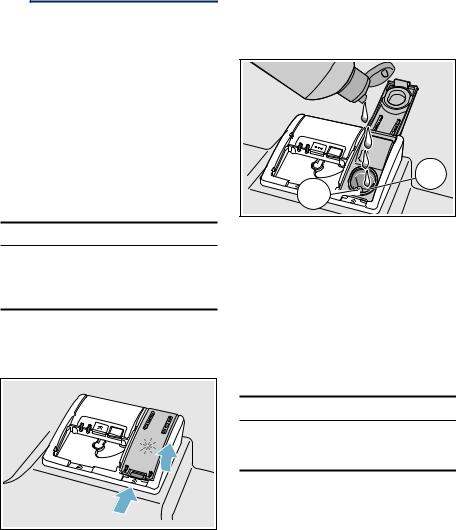
,Rinse Aid
To achieve proper drying, always use a liquid rinse aid, even if your detergent contains a rinse aid or drying additive.
Note: The dishwasher indicates low rinse aid by turning on the Rinse Aid indicator. If this indicator lights up, you need to refill the rinse aid dispenser 9* by following the directions below.
Adding rinse aid
NOTICE
To avoid oversudsing or clogging, do not overfill the rinse aid
dispenser 9*. Wipe up any spills with a damp cloth.
1.Open the rinse aid dispenser 9* by pressing on the latch of the lid and pull it open.
|
|
Rinse Aid en-us
2.Add liquid rinse aid to the dispenser 9* until it is full. Do not overfill. Avoid spilling into air vent hole.
PD[ |
BJS |
WFOU |
3.Close the lid. Lid must be fully closed until it clicks in order to seal.
4.Wipe up any excess rinse aid that
may have puddled when the dispenser reservoir is full.
The indicator light will go out a few moments after the dishwasher door is shut.
Tip: For easier pouring, remove lid from the rinse aid bottle.
NOTICE
Do not fill the rinse aid dispenser 9* with detergent. Doing so will damage the dishwasher.
15

en-us Rinse Aid
Setting the amount of rinse aid used
The amount of rinse aid dispensed can be set from §:‹‹ to §:‹‡. The factory setting is §:‹†.
You should only change the setting if streaks remain on the dishes (lower the amount), or if dishes are not getting dry enough (increase the amount).
Setting |
Amount |
§:‹‹ |
dispenser is OFF |
§:‹‚ |
lowest setting |
§:‹ƒ |
low setting |
§:‹„ |
medium setting |
§:‹… |
medium/high setting |
§:‹† |
high setting |
§:‹‡ |
highest setting |
|
|
1.Press the On/Off button (.
2.Hold down the function key # and press the Start button P until the display 8 indicates
•:‹x or š:‹x (x can be any number). Release both buttons.
3.Press the function key # until the display 8 shows §:‹†.
4.Press the function key 3 to select the desired setting.
5.Press the Start button P to save the setting.
Turning off rinse aid indicator
Proceed as described in the section “Setting the amount of rinse aid used” and set value to §:‹‹. The rinse aid indicator is now turned off.
NOTICE
Using no rinse aid or setting the dispenser to §:‹‹ may result in longer cycle times consuming more energy and water. The higher temperatures and longer cycle times can damage fine china or glassware.
16

-Loading the Dishwasher
Dishware material
Note: Before using your dishwasher for the first time, check the information in this section. Some items are not dishwasher-safe and should be hand washed; others require special loading.
Recommended |
|
Aluminum |
Colored anodized aluminum |
|
may fade over time. |
|
Minerals in your water may |
|
cause the aluminum to |
|
darken or spot. This can |
|
usually be removed with a |
|
soap-filled steel wool pad. |
China, Crystal, |
Some hand-painted utensils |
Stoneware |
may discolor, fade or spot. |
|
Hand wash these utensils. |
|
Position fragile glassware so |
|
that it will not topple over or |
|
come in contact with other |
|
utensils during the wash |
|
cycle. |
Glass |
Make sure to use |
|
dishwasher-safe glass. Milk |
|
glass may discolor or |
|
become yellow. |
Non-stick |
Apply a light coating of |
Coatings |
vegetable oil to non-stick |
|
surfaces after drying. |
Plastics |
Make sure the plasticware is |
|
dishwasher-safe. |
Stainless Steel, |
Load these so they do not |
Sterling Silver |
come in contact with other |
and Silver |
metals, stainless steel |
Plates |
dishwasher tub walls or the |
|
inner door. |
|
|
Loading the Dishwasher en-us
Not Recommended
Acrylic |
Crazing or small cracks |
|
throughout the acrylic, may |
|
occur. |
Adhesive- |
Adhesives that join |
Joined Pieces |
materials such as plastic, |
|
wood, bone, steel, copper, |
|
tin, etc. may loosen. |
Bone-Handled |
Handles may separate. |
Utensils |
|
Iron |
Iron will rust. Hand wash |
|
and dry immediately. |
Non-Dishware |
Your dishwasher is intended |
Items |
for use in cleaning ONLY |
|
standard household |
|
dishware and kitchenware. |
Pewter, Brass, |
These items will tarnish. |
Bronze |
Hand wash and dry |
|
immediately. |
Tin |
Tin will stain. Hand wash |
|
and dry immediately. |
Wood |
Wooden bowls, wooden |
|
utensils and utensils with |
|
wooden handles can crack, |
|
warp and lose their finish. |
|
|
17

en-us Loading the Dishwasher
Loading the racks
For best dishwashing results, observe the following when loading the dishwasher:
■Do not pre-wash items with loosely attached food soil.
■Remove all food particles, bones, toothpicks and excessive grease.
■Pre-treat items having burned-on, baked-on or starchy soils.
■Load dishes in the dishwasher racks so the insides of bowls, pots and pans are facing the spray arms.
■Avoid nesting and contact points between dishes.
■Separate items of dissimilar metals. Use care to not block movement of the spray arms.
■Only wash household dishware and kitchenware rated as dishwasher-safe.
Refer to the Dishware Materials section for more information about dishware suitability.
NOTICE
To avoid dishwasher damage, do not load the dishwasher with paper products, plastic bags, packing materials or anything other than normal, dishwasher safe dishware and kitchenware.
Loading the upper rack
Ensure items do not protrude through the bottom of the racks and block the spray arms.
Note: When pushing the upper
rack 12 into the dishwasher, push it until it stops against the back of the tub so the upper rack spray
arm 1: connects to the water supply at the back of the tub. Do not push racks in using the door.
Loading the lower rack
Place large items in the lower
rack 9". Load pots, pans and bowls upside down. Do not block the vent hole 1J with tall baking sheets. Load these items on the right side of the dishwasher.
18
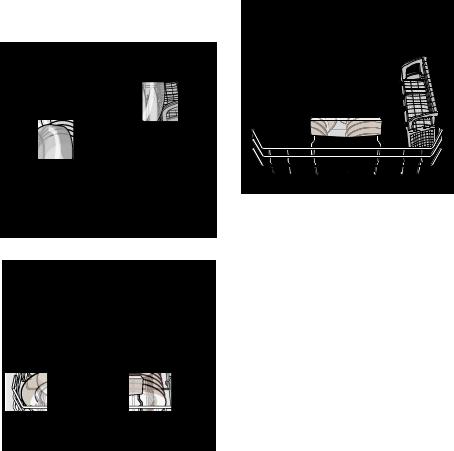
Loading patterns for lower rack
12 place setting suggested loading pattern
Alternate loading pattern
Loading the Dishwasher en-us
Alternate loading pattern with pots and pans
For best results, load large items face down in the lower rack.
19
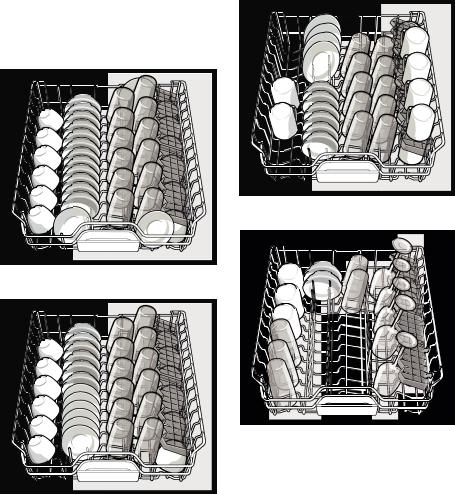
en-us Loading the Dishwasher
Loading patterns for upper rack
12 place setting suggested loading pattern, with third rack cutlery drawer *
12 place setting suggested loading with My Way Rack™ *
Alternate loading pattern
Alternate loading pattern with stemware
Use supports to load stemware glasses in the upper rack.
* optional feature which may or may not be included with your dishwasher.
20
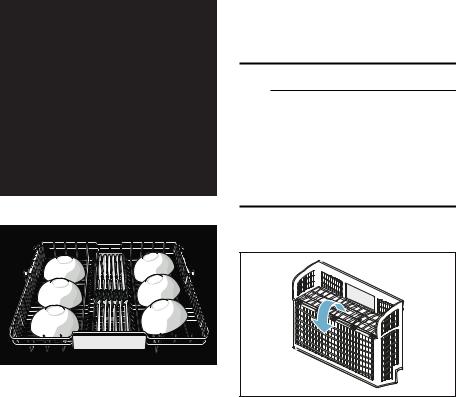
Loading patterns for third rack
12 place setting suggested loading pattern *
My Way Rack™ *
* optional feature which may or may not be included with your dishwasher.
Loading the Dishwasher en-us
Loading the silverware basket
Place knives and sharp utensils with their handles up and forks and spoons with their handles down. If large or oddly-shaped items are loaded in the silverware basket, be sure they do not nest together.
9 WARNING
RISK OF INJURY!
The sharp points and edges of knives and other sharp utensils can cause serious injury. Load knives and other sharp utensils with edges down. Do not allow children to handle or play near knives and sharp utensils.
Long silverware basket*
Note: The silverware basket lid may also be folded downward in order to leave the basket open.
* optional feature which may or may not be included with your dishwasher.
The Double Flex silverware basket *
This basket splits along its length, resulting in two halves that may be placed in a variety of positions in the lower rack 9", greatly increasing the lower rack’s loading versatility. The basket snaps together either side by side or back to back.
21
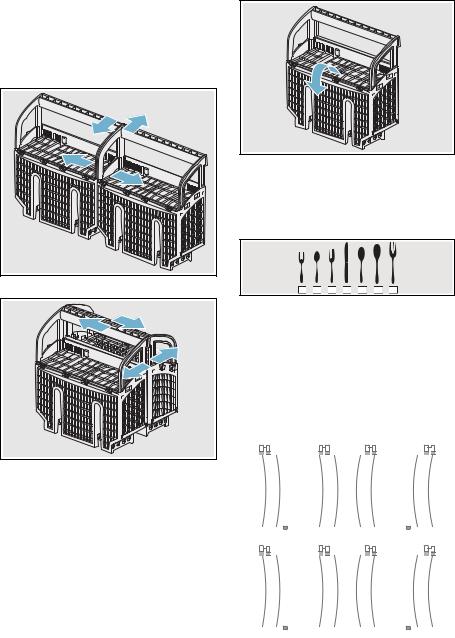
en-us Loading the Dishwasher
To split the Double Flex silverware basket:
Grasp the basket and slide the two halves in opposite directions and then pull the two halves apart.
Side by side
|
|
|
|
|
|
|
|
Back to back
|
|
|
|
|
|
To assemble the Double Flex silverware basket:
Hold the two halves side by side or back to back, so that the tab on one basket can slip into the notch on the other basket. Push the two halves in opposite directions until they click.
Note: The silverware basket lid may also be folded downward in order to leave the basket open.
* optional feature which may or may not be included with your dishwasher.
Suggested loading patterns












1Salad fork
2Teaspoon
3Dinner fork
4Knife
5Tablespoon
6Serving spoon
7Serving fork
Long silverware basket
|
|
|
|
|
|
|
|
|
|
|
|
|
|
|
|
|
|
|
|
|
|
|
|
|
|
|
|
|
|
|
|
|
|
|
|
|
|
||||
|
|
|
|
|
|
|
|
|
|
|
|
||
|
|
|
|
|
|
|
|
|
|
|
|
|
|
|
|
|
|
|
|
|
|
|
|||||
|
|
|
|
|
|
|
|
|
|
|
|
|
|
|
|
|
|
|
|
|
|
|
|
|
|
||
|
|
|
|
|
|
|
|
|
|
|
|
|
|
|
|
|
|
|
|
|
|
|
|
|
|
||
|
|
|
|
|
|
|
|
|
|
|
|
|
|
|
|
|
|
|
|
|
|
|
|
|
|
|
|
|
|
|
|
|
|
|
|
|
|||||
|
|
|
|
|
|
|
|
|
|
|
|
|
|
|
|
|
|
|
|
|
|
|
|
|
|
|
|
22
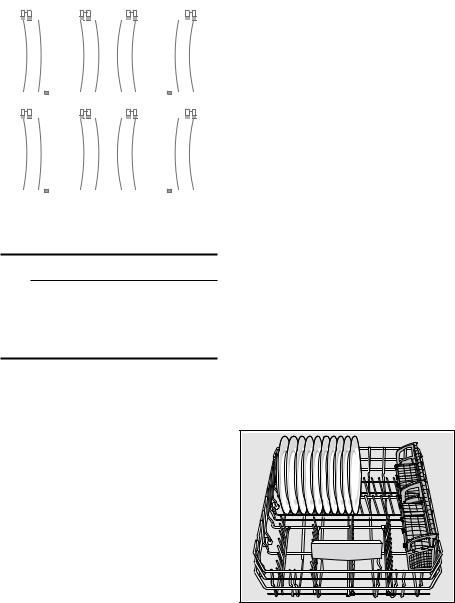
Double Flex silverware basket
|
|
|
|
|
|
|
|
|
|
|
|
|
|
|
|
|
|
|
|
|
|
|
|
|
|
|
|
|
|
|
|
|
|
|
|
|
|
|
|
|
|
|
|
|
|
|
|
|
|
|
|
|
|
|
|
|
|
|
|
|
|
|
|
|
|
|
|
|
|
|
|
|
|
|
|
|
|
|
|||||
|
|
|
|
|
|
|
|
|
|
|
|
|
|
|
|
|
|
|
|
|
|
|
|
|
|
||
|
|
|
|
|
|
|
|
|
|
|
|
|
|
|
|
|
|
|
|
|
|
|
|
|
|
|
|
|
|
|
|
|
|
|
|
|
|
|
|
|
|
|
|
|
|
|
|
|
|
|
|
|
|
|
|
|
|
|
|
|
|
|
|
||||||
|
|
|
|
|
|
|
|
|
|
|
|
|
|
|
|
|
|
|
|
|
|
|
|
|
|
|
|
Unloading the dishwasher
9 CAUTION
Dishes can be very hot immediately after cycle ends. Open the door slightly and allow dishes to cool for a few minutes before unloading.
Note: Dishes are more likely to chip when unloading before cooling.
When unloading the dishwasher, to prevent water from dripping onto dry dishes, unload the lower
rack 9" first. Next, unload the silverware basket 1j followed by the upper rack 12, and then the third rack (if equipped).
Loading the Dishwasher en-us
Adjusting the height of the rack
If desired, the height of the upper rack 12 can be adjusted to create more space for taller utensils either in the upper or lower rack.
With |
Upper rack |
Lower rack |
silverware |
|
|
basket |
|
|
Setting 1 |
9.4 in |
13.4 in |
max. ø |
(24 cm) |
(34 cm) |
Setting 2 |
10.4 in |
12 in |
max. ø |
(26.5 cm) |
(30.5 cm) |
Setting 3 |
11.4 in |
11 in (28 cm) |
max. ø |
(29 cm) |
|
|
|
|
With |
Upper rack |
Lower rack |
third rack |
|
|
Setting 1 |
7 in (18 cm) |
13.4 in |
max. ø |
|
(34 cm) |
Setting 2 |
8 in |
12 in |
max. ø |
(20.5 cm) |
(30.5 cm) |
Setting 3 |
9 in |
11 in (28 cm) |
max. ø |
(23 cm) |
|
|
|
|
Arrange large plates up to a diameter of 13.4 in (34 cm) in the lower basket 9" as illustrated.
23
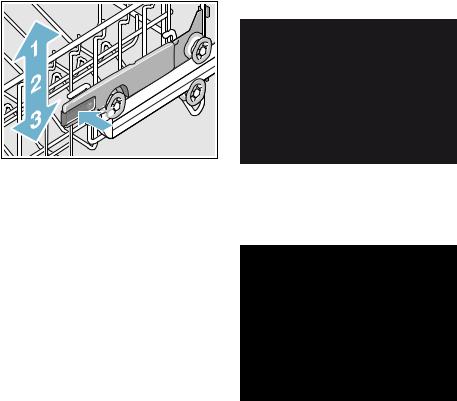
en-us Loading the Dishwasher
RackMatic®
The height of the upper rack 12can be adjusted in 3 steps to create more space.
1.Pull the upper rack out of the dishwasher until it stops.
2.To lower the rack, push the RackMatic® lever inward.
3.To raise the rack, hold the basket on the sides of the upper rack and lift it up.
Note: Check spray arm for clearance after adjustment.
Rack accessories
Flip tines
The upper and lower rack are fitted with flip tines that can be folded down depending on what you may need to load in the rack.
Lower rack flip tines: To fold down, pull flip tine gently forward and release it from the notch. Push the flip tine downward. To fold up, push flip tines into an upright position until the holder engages in the notch.
|
|
Upper rack flip tines: To fold down, push flip tines downward with gentle pressure. To fold up, push flip tines into an upright position until the holder engages in the notch.
24
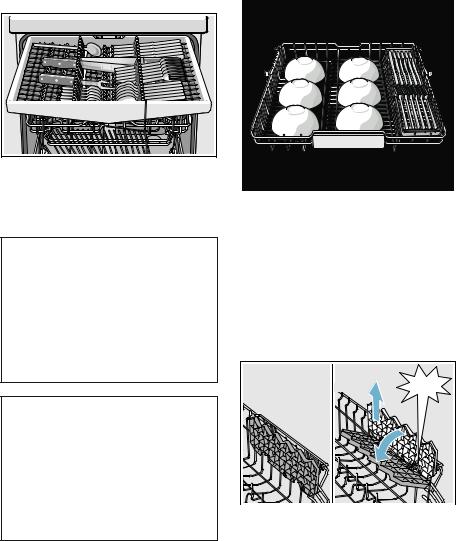
Third rack
The third rack 1* horizontally positions knives, spatulas and other oversized tools for improved cleaning and easier loading and unloading. Arrange cutlery in third rack as illustrated.
You can fold down the side shelves to provide more room for taller items of silverware.* The front rows of prongs can be folded down to provide room for wider handles.
&/,&. |
* optional feature which may or may not be included with your dishwasher.
Loading the Dishwasher en-us
My Way Rack™ *
This third rack is ideal for small bowls, spatulas and other oversized tools for improved cleaning and easier loading and unloading. Arrange cutlery in cutlery insert.
* optional feature which may or may not be included with your dishwasher.
Cup shelves
The cup shelves and the space underneath them can be used for small cups or for larger serving utensils. They also serve as stemware supports.~ "Loading patterns for upper rack" on page 20
&/,&. |
25
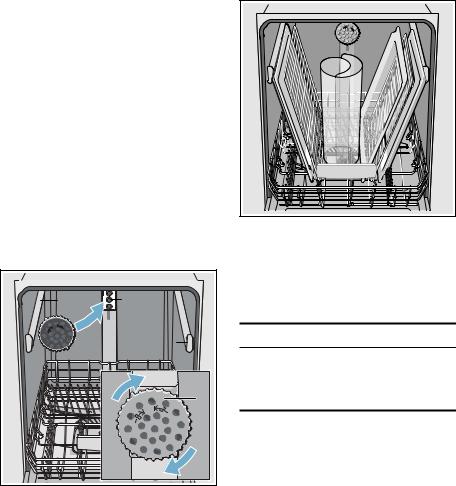
en-us Loading the Dishwasher
Extra tall item sprinkler*
If an item is too tall to be placed in the lower rack 9" even with the upper rack 12 in the raised position, remove the empty upper rack 12 by pulling it out of the dishwasher until it stops. Pull the front of the rack upward and outward until the rack will not slide out anymore. Then lift it up and away from the dishwasher, until the rollers are completely free of the roller guides (A).
Set the upper rack 12 aside and push the roller guides (A) back into the dishwasher. Insert the extra tall item sprinkler (B) into the upper rack spray outlet (C) and turn the sprinkler clockwise to lock into position.
$ |
& |
|
$ |
|
% |
Note: Keep the vent hole 1J on the tub’s left side clear by placing tall items such as plastic cutting boards and tall baking sheets on the lower rack’s right side or center.
NOTICE
To avoid dishwasher damage, do not reinstall the upper rack 12 without removing the extra tall item sprinkler (B).
* optional feature which may or may not be included with your dishwasher.
26
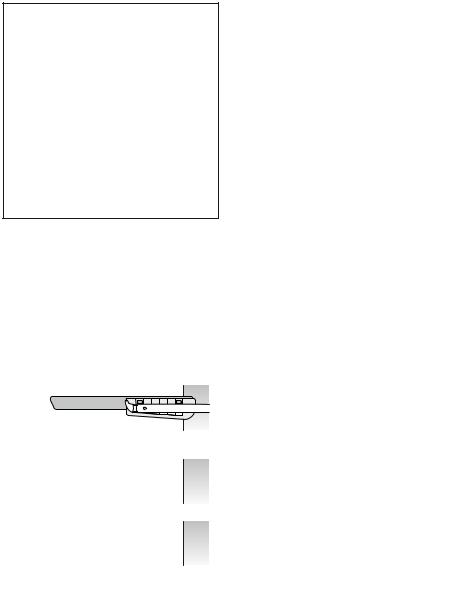
Removing/Installing third |
rack |
Removing third rack 1*
1.Pull out third rack all the way (1).
2.Lift upper rollers over the stopper hooks of both rails (2).
3.Pull third rack out forward and upward so that the holding hooks and the lower rollers of the rack slide over the stopper hooks of both rails (3).
|
|
|
Loading the Dishwasher en-us
Installing third rack 1*
1.Pull out third rack rails all the way (1).
2.Insert third rack at an angle. Make sure that the stopper hooks of both rails slide in between the holding hooks and the lower rollers of the third rack (2).
3.Slide third rack in and lift the upper rollers over the front stopper hooks of both rails (3).
4.Push in third rack (4).
|
|
|
|
27
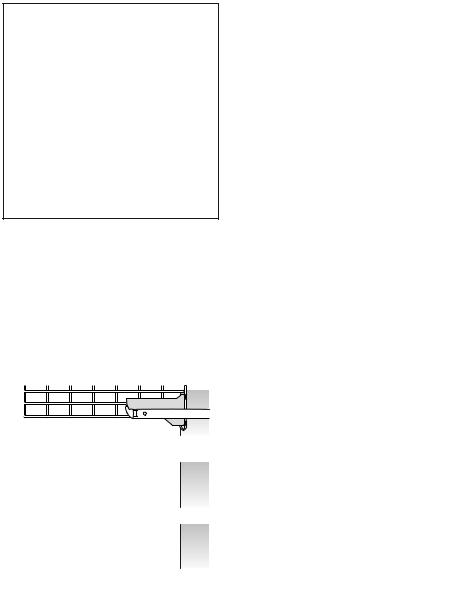
en-us Loading the Dishwasher
Removing/Installing upper rack with Rackmatic®
Removing upper rack 12
1.Pull out upper rack all the way (1).
2.Lift front rollers over the stopper hook of the rail (2).
3.Pull out upper rack forwards and upwards so that the upper and lower rollers of the rack slide over the stopper hooks of both
rails (3).
|
|
|
Installing upper rack 12
1.Pull out upper rack rails all the way (1).
2.Insert upper rack at an angle. Make sure that the stopper hooks of both rails slide in between the upper and lower rollers on the rear side of the rack (2).
3.Slide upper rack in and lift the upper rollers over the front stopper hooks of both rails (3).
4.Push in upper rack (4).
|
|
|
|
28

.Detergent
Use only detergent specifically designed for dishwashers. For best results, use fresh powdered dishwashing detergent or detergent tabs.
NOTICE
To avoid damage to dishwasher or dishware:
■Do not use hand dishwashing products in your dishwasher.
■Do not use too much detergent if your water is soft. Using too much detergent with soft water may cause etching in glassware and fine china.
■To best protect glassware, use a wash cycle with low temperatures or a specific glass-care cycle (depending on the model) and use a detergent that includes etch protection.
Detergent en-us
This dishwasher uses less water than most, therefore, less detergent is required. With soft water,
1 tablespoon (15 ml) of detergent will clean most loads. The detergent dispenser cup has lines that measure detergent to 1 tablespoon (15 ml) and 1.75 tablespoons (25 ml).
3 tablespoons (45 ml) of detergent will completely fill the detergent dispenser.
Note: If you do not know the hardness of your water supply, use 15 ml of detergent. Increase the amount if necessary to the least amount required to get your kitchenware clean.
Use the measuring lines in the detergent dispenser cup as a guide to measure the amount of detergent recommended in the following table.
Wash Cycle |
Hard Water/ |
Medium Water/ |
Soft Water/ |
|
Heavy Soil |
Medium Soil |
Little Soil |
Heavy |
3 tbsp |
3 tbsp |
1.75 - 3 tbsp |
|
(45 ml) |
(45 ml) |
(25 - 45 ml) |
Auto |
1.75 - 3 tbsp |
1.75 tbsp |
1 - 1.75 tbsp |
|
(25 - 45 ml) |
(25 ml) |
(15 - 25 ml) |
Eco |
1.75 tbsp |
1 - 1.75 tbsp |
1 tbsp |
|
(25 ml) |
(15 - 25 ml) |
(15 ml) |
Normal |
1.75 - 3 tbsp |
1.75 tbsp |
1 - 1.75 tbsp |
|
(25 - 45 ml) |
(25 ml) |
(15 - 25 ml) |
Speed60® |
1.75 tbsp |
1 - 1.75 tbsp |
1 tbsp |
|
(25 ml) |
(15 - 25 ml) |
(15 ml) |
Rinse |
none |
none |
none |
|
|
|
|
29
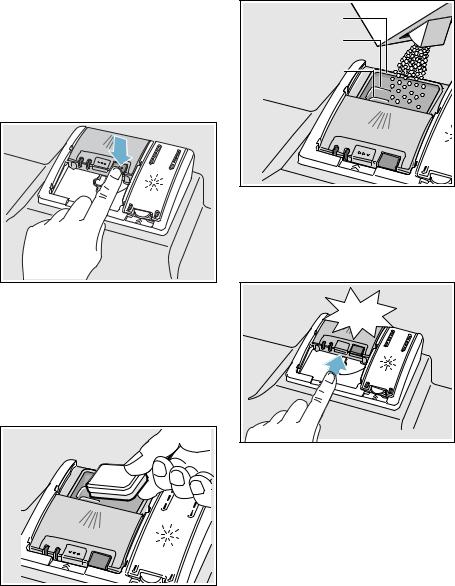
en-us Detergent
Adding detergent
1.If the detergent dispenser 92 is still closed, push the button 9: to open it.
Note: Make sure the detergent dispenser is dry and clear of detergent residue.
2.When using detergent tabs, lay them such that they do not come in contact with the cover, insert a detergent tab flat, not on its side.
Note: Do not place detergent tabs or utensils in the detergent tab tray 1B. Place tabs or other detergent forms directly in the detergent dispenser 92.
Pour detergent into the dry detergent dispenser 92 only. Add detergent. Do not overfill the detergent dispenser.
PD[ |
WEVS PO |
WEVS PO |
WEVS PO |
Dosage: see manufacturer’s instructions on the packaging.
3.Close the lid by placing the finger on the lid as shown. Slide the lid closed until it clicks.
&/,&. |
The detergent dispenser will open automatically at the ideal time for the set cycle. The powder or liquid detergent is distributed in the appliance and is dissolved, detergent tabs will fall into the detergent tab tray 1B where it dissolves during the cycle.
Tip: If the dishware is only lightly soiled, slightly less than the indicated amount of detergent is usually adequate.
30
